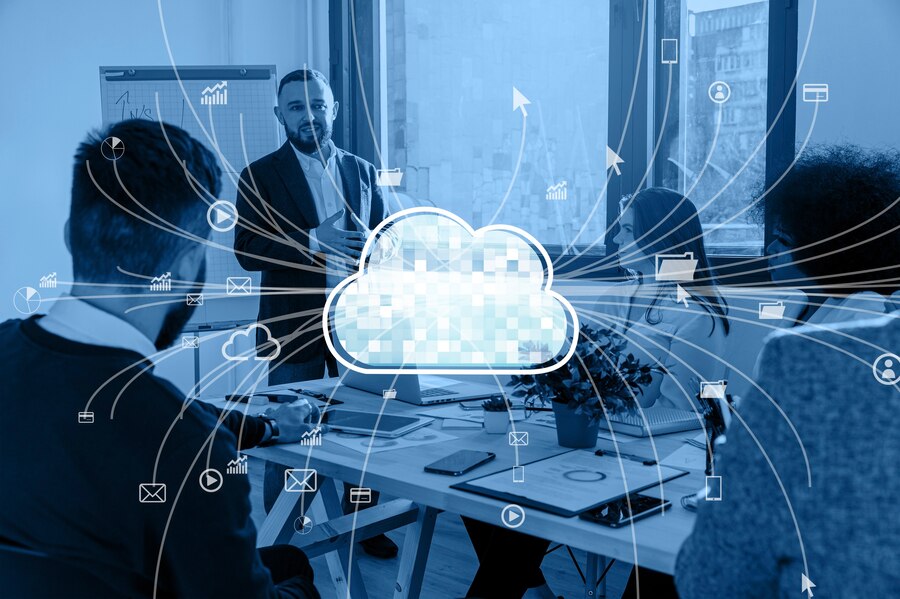Scaling Your Business with DaaS in Cloud Computing
-
April 23, 2024
-
8 min read

Success in today’s quickly changing corporate environment depends heavily on scalability and agility. Your company’s IT needs change as it expands. On the other hand, maintaining on-premises IT infrastructure can be a significant waste of time and resources, making it more challenging to respond quickly to changing needs.
Desktop as a Service (DaaS) has become revolutionary in this regard. DaaS, a crucial element of cloud computing, provides enterprises of all sizes with an adaptable and affordable solution.
By 2024, around 80% of all virtual desktops offered to remote users will be DaaS, up from less than 30% in 2021. The swift expansion highlights the growing acknowledgement of DaaS’s value proposition.
Introduction to Desktop as a Service
A revolutionary cloud computing technology known as Desktop as a Service (DaaS) enables users to access and use virtual desktops from any place with an internet connection. This removes the requirement for companies to purchase, handle, and keep up licenses for desktop applications and physical hardware. Rather, these duties are carried out by DaaS providers, sometimes referred to as hosted desktop service providers, who provide a subscription-based method for accessing virtual desktops on distant servers.
This technology is an attractive option for companies looking to strengthen remote work policies. Instead of providing every worker with a standard desktop or laptop, companies may use DaaS providers to offer safe virtual desktops that are reachable from any internet-connected device. This lessens the need for hardware and software administration while promoting a more flexible work environment.
Advantages Of DaaS:
DaaS provides companies with several strong benefits, such as:
Scalability:
You may quickly add or remove users and resources to meet changing company demands without dealing with the hassles and expenses of maintaining physical infrastructure.
Cost-Effectiveness:
You pay only for the resources you use, eliminating upfront software and hardware expenses. By managing infrastructure updates and maintenance, DaaS providers save recurring IT costs.
Enhanced Security:
Information is safely kept in the DaaS cloud, where DaaS providers have established strong security mechanisms to safeguard user data and apps.
Enhanced Accessibility:
You can utilize your applications and desktop as a service (DaaS) from any internet-connected device to facilitate remote work and enhance teamwork.
Simplified Management:
Your IT staff can concentrate on your company’s primary needs by having daas providers manage desktop provisioning, patching, and upgrades.
Flexibility:
Desktop as a service DaaS gives you many customization choices to personalize virtual desktops with the exact tools and applications your staff members need.
DaaS in cloud computing fits well with other service models, such as SaaS, PaaS, and IaaS, which provide companies several ways to use cloud technologies customized to meet their unique requirements.
How does DaaS work?
An internet connection will allow you to be in a virtual office space from anywhere, taking advantage of Cloud Desktop as a Service (DaaS), which will give you easy access to your files and applications. Let us, therefore, unfold the workings of this amazing technology by getting into details of its basic elements and how they are interconnected.
Cloud servers:
Sturdy and reliable, these servers serve as central stores for user information, apps, and virtual desktops. Your virtual office environment is accessible on demand thanks to these scalable and secure resources.
Software for virtualization:
This essential layer divides server resources effectively, allowing the establishment and administration of several separate virtual desktops on a single physical server. This maximizes cost-effectiveness and resource usage.
Broker of links:
Consider this as a sophisticated traffic controller. Authorized users are connected to their designated virtual desktops with ease, guaranteeing a safe and easy login process.
User portal:
Your workforce’s single point of entry is this safe online interface. The portal may be used by users to manage their workspaces, access their virtual desktops, and authenticate.
Operating system images:
These virtual desktops come pre-installed with all the necessary tools and programs to speed up user onboarding and maintain uniformity throughout the company.
Application delivery:
This dynamic service makes it easier for consumers to access applications. It makes sure that necessary apps are always available when needed in the virtual desktop environment, which promotes productive workflows.
Storage:
User data and application settings are digitally stored in a safe, centralized cloud. This makes data accessible and persistent even if a virtual desktop is reset.
Network infrastructure:
A high-performance network infrastructure is the vital link bridging your on-premises system with the cloud-hosted virtual desktops. It ensures quick and dependable data transfer, allowing for a flawless user experience.
Security procedures :
These include continuous threat monitoring, data encryption, and multi-factor authentication procedures to safeguard private data and provide a safe working environment.
Adding the following components to the user-provider-network triangle:
User:
Regardless of the device you use to access it, you are walking through a portal to access your virtual workplace and finding everything at your fingertips exactly as you left it.
DaaS provider:
They are in charge of upgrading the security systems and tools, maintaining the building (servers), and ensuring that the office spaces (virtual desktops) are in excellent condition.
Network:
This system provides a safe and effective route for data exchange and real-time communication between your device and your virtual workplace.
DaaS essentially offers a safe, flexible, and maintenance-free working environment so you can concentrate on your business without having to worry about the underlying technology. It’s similar to having your own cloud-based personal office that you can access with any device, from anywhere, at any time.
Difference between VDI and DaaS
Both VDI (Virtual Desktop Infrastructure) and DaaS provide access to virtual desktops. However, key differences exist:
| Feature | VDI | DaaS |
| Infrastructure Management | Managed by the organization’s IT team, requiring in-house hardware and software. | Managed by the cloud provider, reducing the need for on-premises infrastructure. |
| Initial Investment | Higher due to the need for infrastructure and software licenses. | Lower, with costs spread over time as a subscription service. |
| Scalability | Scaling requires additional hardware and can be time-consuming. | Easily scalable, with resources adjusted on-demand without physical hardware limitations. |
| Accessibility | Typically accessed within the organization’s network, though remote access can be configured. | Accessible from anywhere, promoting remote work and flexibility. |
| Security | Security is managed in-house, requiring a dedicated IT security team. | Security is provided by the cloud provider, often with advanced protocols and compliance standards. |
Importance of DaaS
Think of a case where a company, to expand its production and sales capabilities, has people working in different parts of the world. Maintaining effective teamwork and safe access to vital resources will be difficult with this increase. Desktop-as-a-Service (DaaS), on the other hand, shows up as a potent remedy that promotes a more organized and effective work environment. Furthermore, it offers:
Encouragement of remote work:
DaaS makes it possible for staff members to access their work settings from any location with an internet connection, encouraging a flexible work environment and improving the work-life balance of staff members.
Reducing IT workload:
Companies may free up their IT staff’s time to focus on more important duties by outsourcing desktop management to a DaaS provider.
Strengthening security:
DaaS providers provide another line of defence against cyberattacks by implementing cutting-edge security processes to secure critical company data and applications.
Providing business continuity:
DaaS guarantees that companies can keep access to critical data and apps in the event of unplanned events like natural catastrophes or physical hardware failures, reducing downtime.
Simplifying IT infrastructure:
DaaS streamlines the IT environment by eliminating the requirement for actual desktop upkeep, frees up office space, and lessens reliance on hardware.
DaaS for small businesses
This is because DaaS makes it accessible for even the smallest companies to have big data processing capabilities. It removes the necessity of investing the amount of money in ICT infrastructural investments earlier to buy access to enterprise-level technologies and resources at a relatively lower cost. This becomes a great advantage for startups and small firms in building a place of their own in the market against big business organizations.
Conclusion
The widespread use of Desktop-as-a-Service (DaaS) in cloud computing is bringing about a substantial transformation in the way enterprises oversee their IT infrastructure. The Desktop as a Service DaaS innovations meet the criteria of scalability, cost-effectiveness, enhanced security, and simplified administration and thus, it is the enterprise’s peculiarity to increase efficiency and achieve their growth targets. Serving as the foundation for a myriad of business advancements, the DaaS cloud will stand in as a pivotal resource to apply for firms of all natures. Visit Airtel Business for more details on DaaS and its other services. Airtel offers Public cloud services for the new age business to keep their workforce connected at all points of time and enable better collaboration.
 Share
Share








